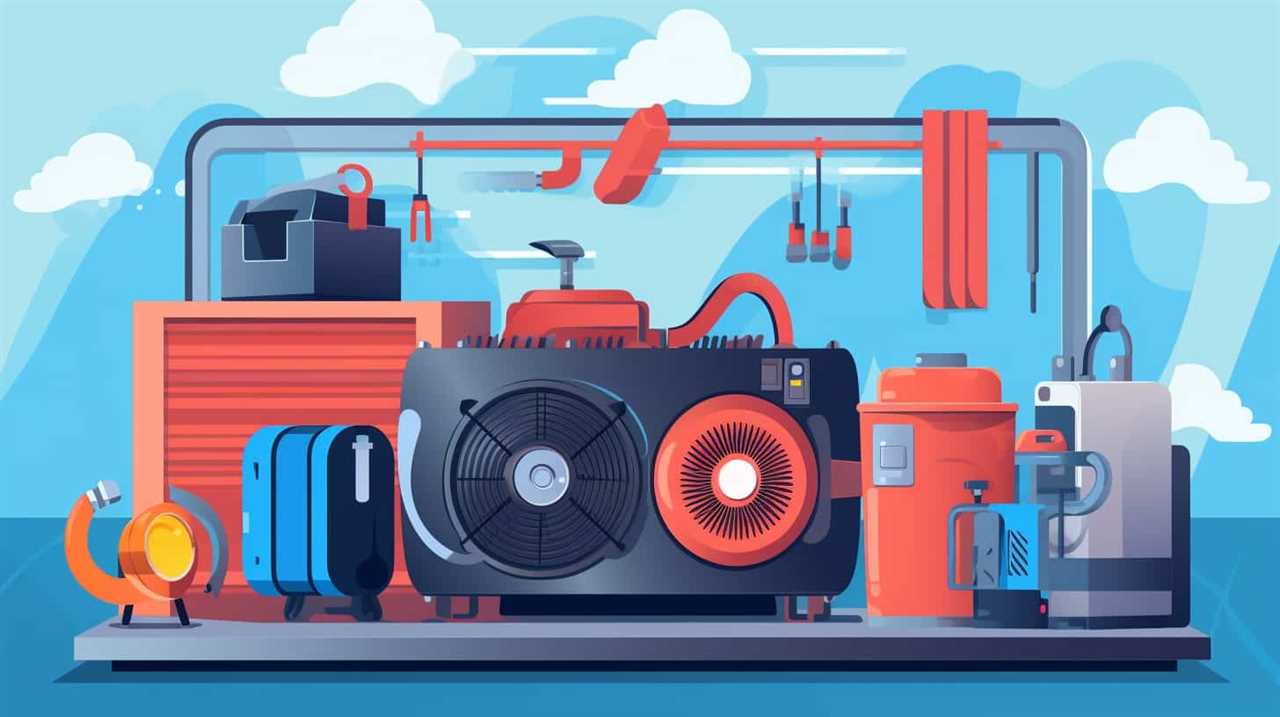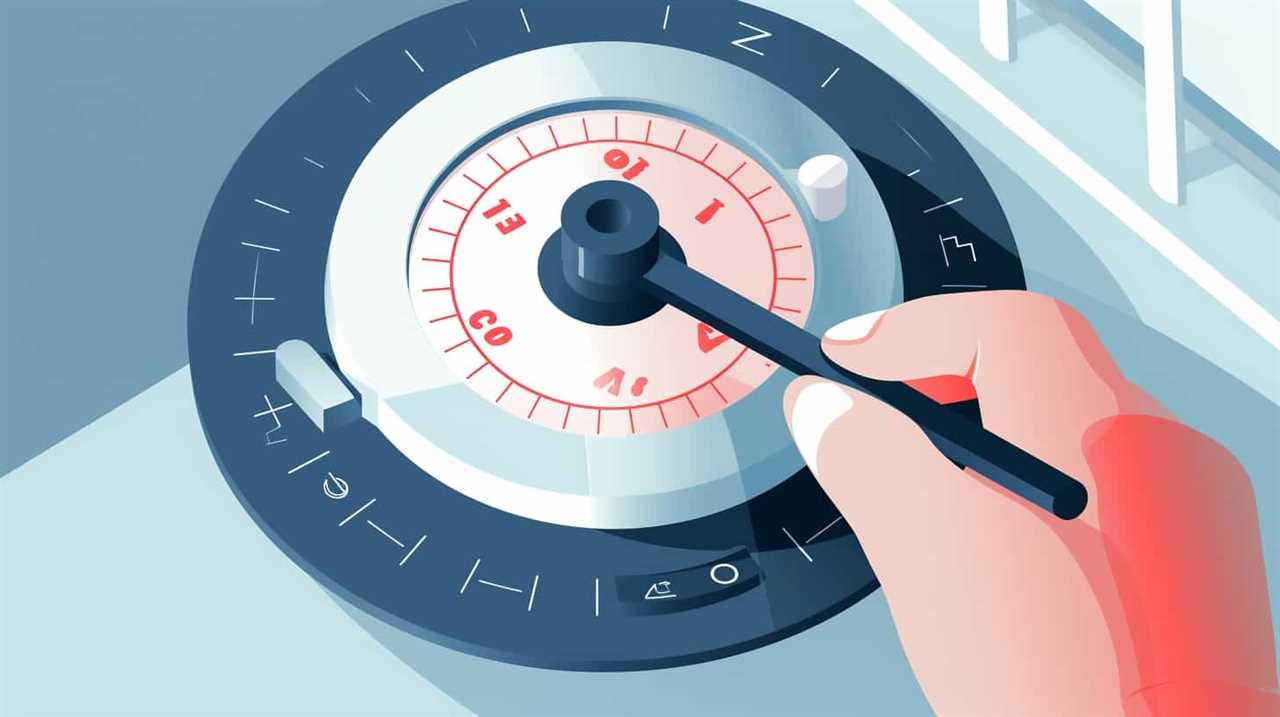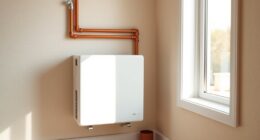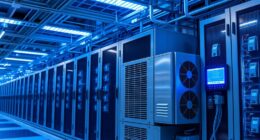Our objective is to help you understand the basics of heat pumps and the principles of the refrigeration cycle completely. With our expertise and reliable information, we are committed to supporting and assisting you in mastering this subject.
In this article, we delve into how heat pumps work, the key components of a heat pump system, and the importance of heat transfer in the refrigeration cycle.
Get ready to enhance your knowledge and maximize energy savings with heat pump efficiency.
Key Takeaways
- Regular maintenance and inspections are crucial for optimal performance and longevity of heat pumps.
- Heat pumps utilize the refrigeration cycle to transfer heat and achieve their cooling or heating effect.
- The refrigeration cycle involves components like the evaporator, compressor, condenser, and expansion valve.
- Efficiency and energy consumption play a significant role in the performance of heat pumps, with higher COP values indicating greater efficiency.
The Basics of Heat Pumps
Let’s dive into the basics of heat pumps.

Heat pump maintenance is crucial to ensure their optimal performance and longevity. Regular inspections and cleanings of the filters, coils, and outdoor unit are necessary to keep the system running efficiently. It’s also important to check the refrigerant levels and ensure proper airflow to avoid any potential issues.
One of the advantages of heat pumps is their energy efficiency. They can transfer heat from the outside air or ground to warm your home, reducing the need for traditional heating methods. Heat pumps are also versatile as they can provide both heating and cooling, making them a convenient option for year-round comfort.
Understanding the Refrigeration Cycle
Let’s now explore the key points in understanding the refrigeration cycle.
Firstly, we’ll delve into the heat transfer process, which is at the core of how heat pumps operate.

Next, we’ll discuss the cooling and heating mechanism, which involves the compression and expansion of refrigerant to achieve the desired temperature changes.
Lastly, we’ll touch upon the efficiency and energy consumption aspects, as these factors play a crucial role in determining the overall performance and cost-effectiveness of heat pumps.
Heat Transfer Process
We use a refrigeration cycle to understand the heat transfer process.
Heat exchange is a fundamental concept in this process, as it involves the transfer of thermal energy from one object to another.

The refrigeration cycle utilizes this principle to achieve its cooling or heating effect.
It works by circulating a refrigerant through various components, such as the evaporator, compressor, condenser, and expansion valve.
These components facilitate the transfer of heat between the refrigerant and the surrounding environment.
Thermal conductivity plays a crucial role in this heat exchange process, as it determines how easily heat can be transferred through different materials.

Cooling and Heating Mechanism
To understand the cooling and heating mechanism, we need to grasp the principles of the refrigeration cycle. This cycle is the heart of cooling and heating technology and is responsible for maintaining temperature control mechanisms.
Here are three key aspects of the refrigeration cycle:
-
Evaporation: The refrigerant absorbs heat from the surrounding air or water, causing it to evaporate and transform from a liquid to a gas state.
-
Compression: The compressor increases the pressure and temperature of the refrigerant gas, making it ready for the next stage.

-
Condensation: The high-pressure gas is condensed into a liquid form by releasing heat to the environment. This process allows the refrigerant to cool down and transfer the heat it absorbed earlier.
Understanding these steps in the refrigeration cycle is essential for comprehending how cooling and heating technology works. By manipulating the refrigerant through these stages, heat pumps can effectively regulate and maintain desired temperatures.
Efficiency and Energy Consumption
Maximizing efficiency and minimizing energy consumption are crucial in understanding the refrigeration cycle.
When it comes to heat pumps, energy conservation is of utmost importance. Heat pumps work by transferring heat from a low-temperature source to a high-temperature sink, using a refrigeration cycle.

The efficiency of a heat pump is measured by its coefficient of performance (COP), which is the ratio of heat output to the energy input. A higher COP indicates a more efficient heat pump.
By using the refrigeration cycle, heat pumps can achieve high COP values, making them energy-efficient and environmentally friendly. This is important in reducing the environmental impact of heating and cooling systems.
Understanding the refrigeration cycle allows us to design and operate heat pumps that maximize efficiency while minimizing energy consumption, ultimately contributing to a more sustainable future.
How Heat Pumps Work
Heat pumps work by utilizing a heat transfer process to move heat from one location to another. This process involves the use of refrigerant, which absorbs heat from a low-temperature source and releases it to a higher-temperature sink.

Heat Transfer Process
We can understand how heat pumps work by examining the heat transfer process. Heat transfer mechanisms play a crucial role in the operation of heat pumps, allowing them to transfer heat from one location to another.
The main mechanism used in heat pumps is conduction, which involves the transfer of heat through direct contact between two objects.
Another important mechanism is convection, which occurs when heat is transferred through the movement of fluids or gases.
Lastly, radiation is the transfer of heat through electromagnetic waves.

In heat pumps, these mechanisms work together to extract heat from a low-temperature source and transfer it to a higher temperature destination. Understanding the principles of heat transfer and the thermal conductivity of different materials is essential for designing and optimizing heat pump systems.
Transitioning to the next section, these heat transfer processes contribute to the energy efficiency benefits of heat pumps.
Energy Efficiency Benefits
One of the key advantages of heat pumps is their ability to achieve high energy efficiency ratings. Heat pumps work by transferring heat from one location to another, rather than generating heat from a fuel source. This makes them more energy efficient compared to traditional heating systems. Heat pumps can save energy and reduce utility costs by efficiently moving heat from a cooler space to a warmer space, even in cold weather. This is because heat pumps use electricity to move heat, rather than generating heat themselves. In fact, for every unit of electricity they consume, heat pumps can produce up to three units of heat. This energy-saving feature not only benefits homeowners by reducing their energy bills but also helps to reduce the environmental impact associated with energy consumption.
| Energy Efficiency Benefits | |
|---|---|
| Cost Savings | Reduce utility costs |
| Environmental Impact | Reduce energy consumption, lower carbon emissions |
| Comfort | Provide heating and cooling throughout the year |
Key Components of a Heat Pump System
Let’s take a closer look at the key components that make up a heat pump system. Understanding these components is essential for proper heat pump installation and maintenance. Here are the main parts of a heat pump system:

-
Compressor: This component is responsible for compressing the refrigerant, increasing its temperature and pressure.
-
Condenser: The condenser transfers heat from the refrigerant to the outside air, releasing it outside the system.
-
Evaporator: The evaporator absorbs heat from the indoor air, cooling it down and turning the refrigerant into a gas.
-
Expansion Valve: This valve regulates the flow of refrigerant, allowing it to expand and cool down before entering the evaporator.

-
Refrigerant: The refrigerant is a substance that circulates through the system, absorbing and releasing heat as it changes state.
-
Air Handler: The air handler distributes the heated or cooled air throughout the building, ensuring proper temperature control.
Understanding these key components will help homeowners and technicians effectively install and maintain heat pump systems, ensuring their optimal performance and longevity.
Heat Transfer in the Refrigeration Cycle
When discussing heat transfer in the refrigeration cycle, it’s important to understand the different types of heat transfer involved. These include conduction, convection, and radiation.

Additionally, the role of refrigerants in facilitating heat transfer is crucial, as they absorb and release heat as they circulate through the system.
Lastly, the efficiency of heat transfer is a key factor in determining the overall performance and effectiveness of a heat pump system.
Types of Heat Transfer
In the refrigeration cycle, the heat transfer process involves the movement of heat from one place to another. Understanding the types of heat transfer and the principles behind them is essential for mastering heat pump basics. Here are the three main types of heat transfer:
-
Conduction: This type of heat transfer occurs when heat moves through a solid material or between two objects that are in direct contact. It’s governed by the principle of thermal conductivity, which determines how easily heat can pass through a material.

-
Convection: Convection involves the transfer of heat through the movement of fluids, such as air or liquid. It can occur through natural convection, where heat rises and cooler air or liquid takes its place, or forced convection, which is facilitated by mechanical means.
-
Radiation: Radiation is the transfer of heat through electromagnetic waves. Unlike conduction and convection, it doesn’t require a medium for heat transfer. Examples of radiation include the sun’s heat reaching the Earth or the heat emitted by a glowing fire.
Understanding these types of heat transfer and their underlying principles is crucial for effectively designing and operating heat pump systems.
Role of Refrigerants
We play a crucial role in the heat transfer process of the refrigeration cycle by using refrigerants. Refrigerants are substances that absorb and release heat during the refrigeration cycle, allowing for the transfer of thermal energy. The choice of refrigerant for a heat pump system is important because it affects both the performance and environmental impact of the system.

Here is a table summarizing some important properties of refrigerants:
| Property | Importance | Examples |
|---|---|---|
| Thermal | Affects heat transfer | R-134a, R-410A, R-717 |
| Conductivity | Determines efficiency | R-22, R-32, R-123 |
| Environmental | Impacts climate change | R-290, R-744, R-1234yf |
| Impact | and ozone depletion |
Refrigerants with higher thermal conductivity generally result in better heat transfer efficiency. Additionally, choosing refrigerants with lower environmental impact is crucial in order to reduce greenhouse gas emissions and protect the ozone layer.
Now, let’s delve into the next section to explore the efficiency of heat transfer in the refrigeration cycle.
Efficiency of Heat Transfer
Our understanding of the efficiency of heat transfer in the refrigeration cycle is crucial for optimizing the performance of heat pump systems. Efficient heat transfer is essential for achieving high performance and reducing energy consumption in heat pump systems.

Here are three key factors that contribute to the efficiency of heat transfer in the refrigeration cycle:
-
Heat transfer techniques: Effective heat transfer techniques, such as conduction, convection, and radiation, play a vital role in transferring heat efficiently in the refrigeration cycle. Understanding these techniques and implementing the appropriate heat transfer methods can enhance the overall efficiency of the heat pump system.
-
Heat exchangers: Heat exchangers are essential components in heat pump systems that facilitate the transfer of heat between the refrigerant and the surrounding environment. Optimizing the design and operation of heat exchangers can significantly improve the efficiency of heat transfer.
-
Refrigerant selection: The choice of refrigerant in a heat pump system can impact the efficiency of heat transfer. Selecting a refrigerant with favorable thermodynamic properties, such as high heat capacity and low viscosity, can enhance the heat transfer efficiency.

The Role of Refrigerant in Heat Pumps
To understand the inner workings of heat pumps, it’s essential to grasp the crucial role that refrigerant plays in their operation. Refrigerant is the key component responsible for transferring heat in the heat pump cycle. It absorbs heat from the outdoor air or ground source and releases it into the indoor space. The choice of refrigerant is critical as it affects the efficiency and environmental impact of the heat pump system.
Refrigerants have specific properties that make them suitable for heat pump applications. They have low boiling points, allowing them to evaporate at low temperatures and absorb heat energy efficiently. Additionally, they have high latent heat capacities, enabling them to carry large amounts of heat during phase changes.
However, it’s important to consider the environmental impact of refrigerants. Some traditional refrigerants, such as chlorofluorocarbons (CFCs) and hydrochlorofluorocarbons (HCFCs), contribute to ozone depletion and global warming. To mitigate these effects, modern heat pumps use environmentally friendly refrigerants, such as hydrofluorocarbons (HFCs) with low global warming potential (GWP) or natural refrigerants like carbon dioxide (CO2) and hydrocarbons.
The Evaporator and Condenser in Heat Pumps
The evaporator and condenser are two essential components in heat pumps that play a crucial role in the transfer of heat during the refrigeration cycle.

The evaporator operates by absorbing heat from the surroundings, typically through the use of a refrigerant. It’s designed to facilitate efficient heat transfer by utilizing a large surface area and fins. The refrigerant evaporates as it absorbs heat, changing from a liquid to a low-pressure gas.
The condenser, on the other hand, works to release the heat absorbed by the evaporator. It achieves this by condensing the refrigerant, converting it back into a liquid state. This process is accompanied by the release of heat, which is then expelled to the surroundings.
The efficiency of the condenser is crucial in ensuring optimal heat transfer. Factors such as the design of the condenser coils, the flow rate of the refrigerant, and the temperature difference between the refrigerant and the surroundings all impact its performance.
Compressors and Expansion Valves in Heat Pumps
Let’s explore how compressors and expansion valves play a crucial role in the refrigeration cycle of heat pumps.

The compressor is responsible for increasing the pressure and temperature of the refrigerant, which is then sent to the condenser. This process is vital in transferring heat from the inside to the outside of a building. However, it’s important to note that regular compressor maintenance is essential to ensure optimal performance and prevent breakdowns.
On the other hand, the expansion valve controls the flow of the refrigerant into the evaporator. By regulating the amount of refrigerant entering the evaporator, it ensures efficient heat transfer. Understanding the operation of the expansion valve is crucial for maintaining the overall performance of the heat pump system.
Now that we’ve discussed the role of compressors and expansion valves, let’s dive into the next section about heat pump efficiency and energy savings.
Heat Pump Efficiency and Energy Savings
One of the key benefits of heat pumps is their ability to achieve high energy efficiency, resulting in significant cost savings. To optimize heat pump performance and ensure long-term savings, proper heat pump maintenance is essential.

Here are three important considerations:
-
Regular Filter Cleaning: Clean or replace the air filters every one to three months. Clogged filters restrict airflow, forcing the system to work harder and reducing efficiency.
-
Professional Maintenance: Schedule regular professional maintenance to ensure the system is running optimally. A qualified technician will inspect and clean the coils, check refrigerant levels, and perform any necessary repairs.
-
Thermostat Programming: Utilize programmable thermostats to set temperature schedules that align with your daily routine. Adjusting the temperature when you’re away or asleep can significantly reduce energy consumption.

Troubleshooting Common Issues in Heat Pump Systems
When troubleshooting common issues in heat pump systems, we need to identify the root cause of the problem before attempting any repairs. By using effective troubleshooting techniques, we can quickly diagnose and resolve common malfunctions.
One common issue is a lack of heating or cooling. This can be caused by a faulty thermostat, low refrigerant levels, or a malfunctioning compressor. To address this, we should check the thermostat settings, ensure that the heat pump is receiving power, and inspect the refrigerant levels.
Another common problem is reduced airflow. This can be due to a clogged air filter, blocked vents, or a malfunctioning blower motor. We can troubleshoot this by cleaning or replacing the air filter, clearing any obstructions in the vents, and examining the blower motor for any issues.
Frequently Asked Questions
How Often Should a Heat Pump System Be Serviced?
We recommend regular heat pump servicing to ensure optimal performance. A heat pump maintenance checklist should include checking for signs of system failure such as insufficient heating or cooling, abnormal noises, and high energy bills.

Can a Heat Pump Be Used in Extremely Cold Climates?
Certainly! In extremely cold climates, heat pump efficiency may be affected. However, heat pumps still offer advantages such as lower operating costs and environmental friendliness. Regular servicing can help optimize performance in these conditions.
What Is the Typical Lifespan of a Heat Pump System?
The typical lifespan of a heat pump system can vary depending on factors such as heat pump maintenance and usage. Regular maintenance and prompt attention to signs of heat pump failure can help prolong its lifespan.
Are Heat Pumps Noisy?
Yes, heat pumps can produce noise, but the level varies depending on the model and installation. To reduce noise, soundproofing measures like installing vibration isolators or using sound blankets can be employed.
Can a Heat Pump Be Used for Both Heating and Cooling a Space?
Yes, a heat pump can be used for both heating and cooling a space. It utilizes the refrigeration cycle to transfer heat energy from the outside air or ground to heat or cool the desired space. This versatility contributes to its efficiency and makes it a popular choice for heating and cooling needs. Proper heat pump installation is crucial for optimal performance.

Conclusion
In conclusion, mastering the basics of the refrigeration cycle is essential in understanding how heat pumps work. By comprehending the key components and the heat transfer process, we can appreciate the efficiency and energy savings that heat pump systems offer.
Through troubleshooting common issues, we ensure the optimal performance of these systems. Just like a well-oiled machine, a well-maintained heat pump keeps our environments comfortable and our energy usage minimal, creating a harmonious balance between comfort and sustainability.









